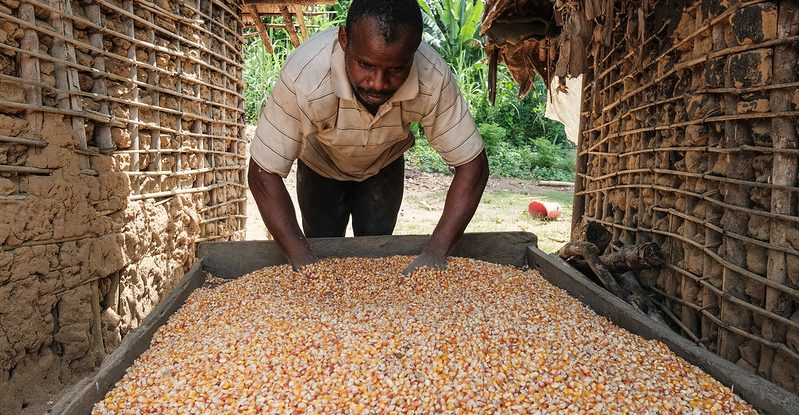Gliding west for the first time through the silent waters and noisy forests of the Congo River from Kisangani to Yangambi, in the northern Democratic Republic of the Congo (DRC), I couldn’t help but think that this place was all water and trees and fishermen hanging onto their nets, children waving excitedly at people as they passed by. I imagined the abundance of fish we might eat later – and salivated at the thought.
Once the speedboat transporting me and my colleagues anchored on the beach, I was excited to touch ground. A few steps in, and the sound of hustling and bustling caught my attention: the local market. I was soon disappointed to notice that only a few fish were for sale there. Other stalls offered remnants of fresh and smoked bushmeat, and small quantities of raw local rice, cassava leaves, roots, and flour.
This meagre showing was likely to represent the most abundant and diverse food on offer in Yangambi, I thought to myself – that is, until I met Julianus Thomas, a Master Trainer for the Sustainable Production and Resilience for Food Crisis Prevention in the Yangambi Landscape project (FORETS-Food), who is based at the Center for International Forestry Research and World Agroforestry (CIFOR-ICRAF)’s Yangambi camp.
Anchored within the CIFOR-ICRAF’s larger and long-term engagement in the Yangambi Landscape – targeting improved incomes and biodiversity conservation – the 2023–2026 FORETS-Food project is an emergency response to increase food security by improving production and harvests of widely grown crops, promoting crop diversification, and implementing post-harvest measures.
Diversifying food sources, increasing quantities
I came across ‘Papa Manure’, as Thomas is affectionately called by the locals, in a small garden at the back of the camp tending to thriving crops of tomatoes, pumpkins, lemon cucumbers, ginger, watermelon, beans, cabbage, and eggplants. When I asked him how it was possible to grow such a range of foods there, he replied that “all of these can grow in Yangambi, I assure you – and with just a little bit of care, a lot more can be done.”
“For many years, slash-and-burn agriculture, hunting, industrial and artisanal logging and mining, and charcoal making, have been the norm around here, contributing to rampant deforestation. Certain agricultural practices in particular, for example, have limited local food sources and yields,” Thomas explained. “Today, together with thousands of local farmers and their families, we are working on testing and adopting new farming methods and diverse crops that fit the typology of their soils, and equally, sharing techniques to increase food yields for local crops like cassava, banana, rice, corn, and beans.”
Learning by doing
Thomas and his team are using the Farmer Field School (FFS) approach to effectively implement FORETS-Food activities. FFS are a participatory and inclusive approach to strengthen the capacity of local populations for efficient and sustainable food production in, with, and for communities. Developed by the UN’s Food and Agricultural Organization (FAO) over two decades ago in Southeast Asia, this approach allows farmers in communities to test and compare alternative practices and traditional systems, under the guidance of a trained facilitator, to assess and adopt best practices for agricultural output.
As a seasoned FFS Master Trainer who has tested and implemented the approach across various countries and landscapes in Africa, Thomas believes that the time has come for innovative farming in Yangambi. The project provides ‘learning by doing’ support to local communities through awareness-raising, and mentoring actions in the field – including long-term resident trainings in active farms, testing and knowledge sharing on pilot farms, and community demonstrations in field schools and individual plots.
From national dreams to local realities
Like many other regions in the world, the Yangambi Landscape (which includes the Provincial capital Kisangani and its neighbouring rural areas) is fighting hard to improve food security. The importance of diversifying incomes and economic activities, and improving practices, is high on the agenda of local chiefs, provincial ministers, and the national government. Efforts must now turn to transforming pledges into real impacts on the ground.
“The team is collaborating with thousands of farmers to translate national dreams into local realities. Implementation is not easy as basic seed, processing, and transport systems needs huge improvements, but local markets such as Kisangani have huge potential, and we have shown that increasing production and yields, while diversifying diets and income sources for families is possible,” said Paolo Cerutti, who manages FORETS-Food at CIFOR-ICRAF.
About FORETS-Food: Implemented by CIFOR-ICRAF, with financial support from the European Union, FORETS-Food works to ensure better harvests, crop diversification, and improved post-harvest phases that play a key role in ensuring sustainable food production, increasing people’s incomes, and fostering resilience to future food-related constraints in the Yangambi Landscape.
We want you to share Forests News content, which is licensed under Creative Commons Attribution-NonCommercial-ShareAlike 4.0 International (CC BY-NC-SA 4.0). This means you are free to redistribute our material for non-commercial purposes. All we ask is that you give Forests News appropriate credit and link to the original Forests News content, indicate if changes were made, and distribute your contributions under the same Creative Commons license. You must notify Forests News if you repost, reprint or reuse our materials by contacting forestsnews@cifor-icraf.org.
